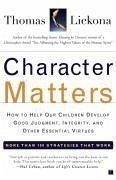The novelist Walker Percy once observed, "Some people get all As but flunk life." Succeeding in life takes character. In Character Matters, award-winning psychologist-educator Thomas Lickona offers more than 100 practical strategies that parents and schools have used to help kids build strong personal character as the foundation for a purposeful, productive, and fulfilling life.
Lickona shows how irresponsible and destructive behavior can invariably be traced to the absence of good character and its 10 essential qualities: wisdom, justice, fortitude, self-control, love, a positive attitude, hard work, integrity, gratitude, and humility. He lays out a blueprint for building these core virtues through a partnership shared by families, schools, and communities. Chapters include:
- 14 strategies that help kids succeed academically while building character
- More than a dozen character-building discipline strategies
- 20 ways to prevent peer cruelty and promote kindness
- 10 ways to talk to teens about sex, love, and character
The culmination of a lifetime's work in character education, this landmark book gives us the tools we need to raise respectful and responsible children, create safe and effective schools, and build the caring and decent society in which we all want to live.
Dieser Download kann aus rechtlichen Gründen nur mit Rechnungsadresse in A, B, BG, CZ, D, DK, EW, E, FIN, F, GR, HR, H, I, LT, L, LR, NL, PL, P, R, S, SLO, SK ausgeliefert werden.









